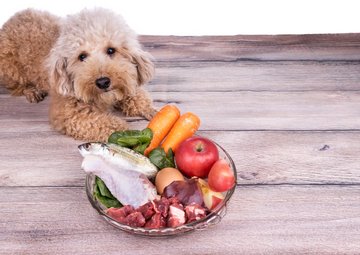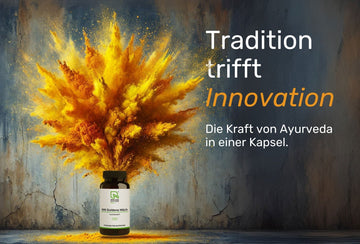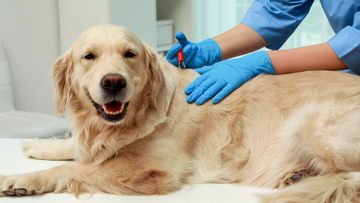BARF stands for "Biologically Appropriate Raw Food." It's a feeding method in which dogs (and cats) are fed primarily raw meat, organ meats, bones, vegetables, fruit, herbs, and high-quality oils. The idea behind it: The diet should be as close as possible to the wolf's natural prey pattern, thus ensuring an optimal supply of nutrients—without any processed foods, artificial additives, or inferior by-products.
Why do many dog owners feed raw food?
More and more dog owners are opting for raw feeding because they want control over the composition of their food and value fresh, high-quality ingredients. By creating their own rations, the diet can be ideally tailored to the dog's age, activity level, or health concerns.
WHAT ARE THE BENEFITS?
- You know exactly what ends up in the bowl
- High acceptance among many dogs
- Visible improvements in coat quality, digestion and vitality
- Lower stool output
- Supports the immune system naturally
As compelling as the benefits of BARF are, raw feeding is not without its challenges. As with any form of feeding, anyone who wants to provide their dog with a species-appropriate and balanced diet needs not only enthusiasm but also in-depth knowledge and a sensitivity to individual needs. Mistakes in the composition of the diet can lead to deficiencies or overdoses. The calcium-phosphorus ratio is particularly critical, as is the adequate supply of essential fatty acids, iodine, zinc, and vitamin D3.
Common challenges:
- Uncertainties regarding the coverage of needs
- Increased storage costs for fresh products
- Risk of hygiene errors (especially with raw meat)
- Not every dog tolerates BARF. For some, cooked rations or special diets are more suitable.
Barfing for beginners: How to get started
If you're considering feeding your dog a raw diet—either partially or completely—it's worth starting with a structured approach. As with any feeding method, raw feeding requires the right balance. The composition of the ration should be carefully planned to prevent deficiencies or overfeeding. The basic rule is: every dog is unique. Their nutritional needs depend on their age, activity level, health status, and individual requirements. Therefore, you should adjust their diet regularly and avoid feeding according to rigid guidelines.
As a rule of thumb, you can expect adult, healthy dogs to eat about 3 % of body weight per day . A 20 kg dog therefore needs around 600 g of food daily , ideally divided into two portions, of which about 70–80 % of animal origin , i.e. meat, offal, bones and fats and 20-30 % plant components such as vegetables, fruits and herbs.
For sensitive dogs, you can replace the bone portion with natural calcium sources such as eggshell powder or algae lime – or you can use micronutrient supplements with products such as BASIC CARE Dog® , which cover the needs safely and in a balanced way.
Especially at the beginning of a transition to BARF, it can be beneficial to specifically support the intestinal flora. ENTEROGENIC Dog® was developed precisely for this purpose. With probiotic cultures (Enterococcus faecium), prebiotic inulin, and herbal ingredients such as black cumin, cinnamon, and algae, it promotes stable digestion and a good gut feeling – especially during the sensitive transition phase.
Important: Every dog reacts differently to a new diet. Give their digestive system time to adjust, start with a few ingredients, and gradually expand the food selection. If in doubt, always seek expert advice.
Which nutritional supplements make sense when feeding raw food?
Nikolaus Nature offers a range of high-quality micronutrients specifically for raw-feeding dogs, free from fillers and with maximum bioavailability:
BASIC CARE Dog®

The perfect basic BARF diet. Contains:
- Vitamin D3, B complex, biotin
- Zinc, selenium, iodine
- L-carnitine and natural algae (Schizochytrium spp.)
Particularly important for covering micronutrient requirements and protecting against typical deficiencies when raw feeding.
ENTEROGENIC Dog®

Ideal for sensitive dogs or those transitioning to a BARF diet. Contains:
- Probiotic cultures (Enterococcus faecium)
- Inulin & black cumin cake to promote healthy intestinal flora
Good for the transition phase and to support digestion.
COXAN Dog "ak"®

To support joints
and musculoskeletal system. Contains, among other things: a.:
- Green-lipped mussel, MSM, collagen
- Vitamins C & E, devil's claw, fish cartilage powder
Particularly recommended for older dogs or active breeds with a higher level of stress.
Conclusion: BARF with brains
Raw feeding can be a very natural, fresh, and healthy way to feed your dog. Provided it's expertly planned and supplemented with targeted ingredients, you'll be well prepared to provide your dog with optimal nutrition—personalized, species-appropriate, and high-quality.
Let's make your dog's life better – naturally!










